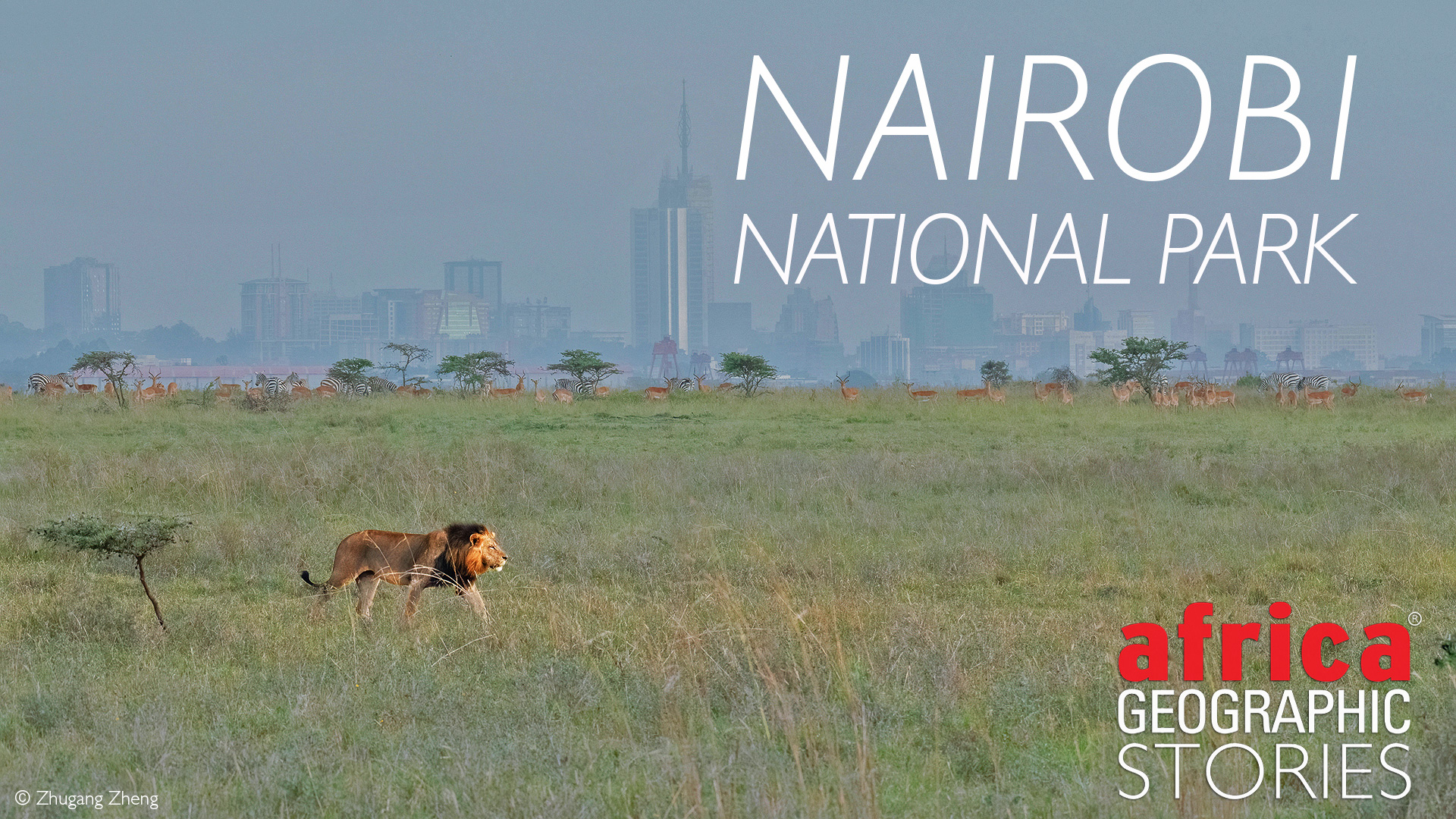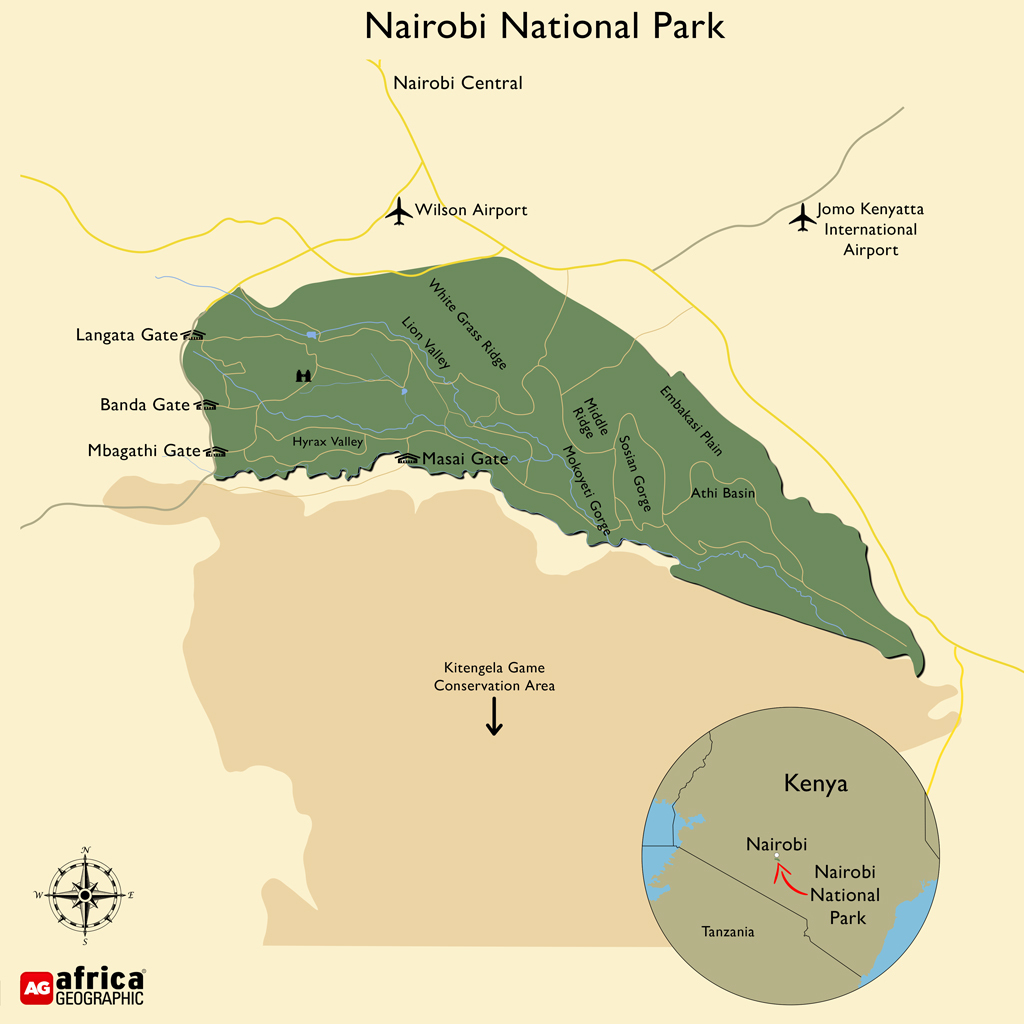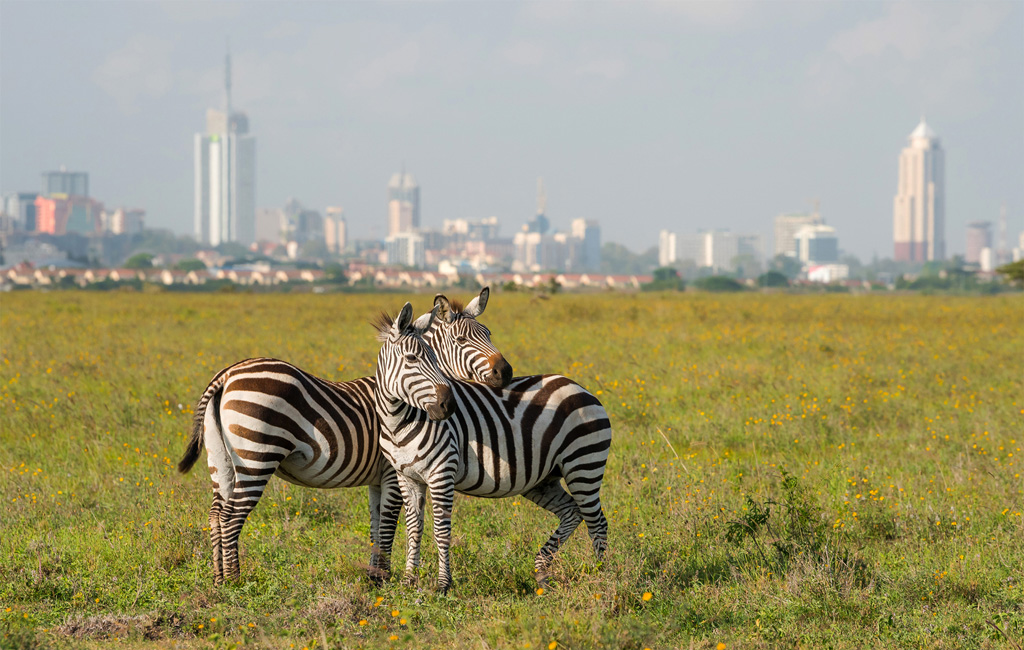
The Ark in the city


It’s an iconic yet incongruous image: a lion strolling on rolling grasslands, all attitude and defiance against the backdrop of the shimmering sprawl of a vibrant capital city skyline. In the heart of Kenya’s capital, Nairobi National Park is one of Africa’s most unique landscapes, suspended at the interface of wilderness and civilisation. No other protected space engenders this deeply poignant metaphor of wildlife and man, and the effect is a safari experience unlike any other.

Nairobi National Park
Nairobi National Park is exactly what the name suggests – a national park pressed against a capital city. Some of Nairobi’s busiest road networks run along the northern boundaries, and the runway of Jomo Kenyatta International Airport is less than five kilometres from the park’s fence. Schools, shopping malls and every conceivable modern convenience lie just a stone’s throw from an open savannah where prides of lion stalk through the grass and herds of wildebeest and zebra migrate with the seasons.

Apart from the intrinsic convenience of such an arrangement, it is the bizarre cognitive dissonance that attracts the park’s annual flood of visitors. This is no zoo, and the animals are as wild as those of the rural regions more often associated with traditional safari fame. Moreover, though the 117km2 (11,700 hectares) park is small compared to other Kenyan giants like Tsavo East and West National Parks or the Maasai Mara National Reserve, it punches far above its weight in historical and conservation value.
For fairly obvious reasons, the entire northern curve of the reserve, including the western and eastern edges, is fenced where it abuts the city. However, the southern boundary, which follows the undulating Mbagathi River, is open to the Kitengela Game Conservation Area to the south. The animals can move in and out of the park through a wildlife corridor stretching to the Athi-Kapiti Plains to the southeast. Nairobi National Park thus forms a vital aspect of the greater Athi-Kapiti ecosystem, allowing for the seasonal migration of many of Nairobi National Park’s animals.


Kifaru’s Ark
Seemingly unperturbed by their proximity to civilisation, the park’s wildlife thrives in the surprising diversity of habitats available, including rolling plains, lush forests, marshlands and stretches of riverine valley. Of the Big 5, only elephants are absent, and the park’s black rhinos are probably the most celebrated residents (to find African safaris that offer the whole Big 5 experience, click here). There are few places in Africa where the chances of encountering a black rhino are as high as in Nairobi National Park. According to Kenyan authorities, the park is home to around a hundred of these endangered pachyderms. Southern white rhinos are present as well, though in smaller numbers, and the park’s success in rhino conservation has earned it the nickname “Kifaru (meaning ‘rhino’ in Swahili) Ark”.

The IUCN Cat Specialist Group recognises the park as a Lion Conservation Unit. At the latest count, over forty lions are wandering the park’s confines. Cheetahs and leopards are less frequently seen, and encounters tend to be fleeting. However, their smaller spotted cousin, the serval, is a common sight. Nairobi National Park is considered one of the best parks in Kenya for these magnificent little hunters. Time spent with servals is guaranteed to be rewarding as they are almost constantly on the move, usually hunting for rodents and birds in the long grasses. Watching the spring-loaded pounce of a serval in action is wild poetry in motion.
Long-limbed giraffes and ostriches delicately pick their way across the plains, outcompeting distant skyscrapers to dominate the horizon while herds of eland nibble through the open woodlands. Impalas, hartebeests, gazelles (Thomson’s and Grant’s) and zebras are ubiquitous, and hippos and crocodiles lurk in the park’s rivers and dams. As evening draws in, the whoops of spotted hyenas and howls of black-backed jackals set up the nightly chorus, cloaking the sounds of the city and creating the impression of a wilderness far removed from humanity’s mark.


Kenya’s many migrations
Kenya is famed for the Maasai Mara section of the Great Migration – an annual circular journey of nearly two million wildebeests and zebras endlessly searching for fresh grazing. However, few people realise that East Africa was once home to several migrations and animal movements as the seasons and rainfall dictated water availability and food abundance. As is the case for thousands of ecosystems across multiple continents, humanity’s relentless growth and development put paid to these ancient cycles as fences, roads, and cities sprung up to block their paths.
However, some of these migrations still occur on a far smaller scale. One such example is the movement of animals from Nairobi National Park to the plains of Athi-Kapiti and beyond. During the wetter months, herds of wildebeest, along with an assortment of other antelopes and zebras, disperse across the open plains of Athi-Kapiti. As the rain dries up and the long dry season sets in, many of these animals travel back north to the reliable water points in Nairobi National Park.
Gauging the historic routes and scale of all-but-extinct animal migrations is a complex exercise, often involving no small amount of guesswork. Though impossible to know for sure, it is likely that the Athi-Kapiti migration once consisted of vast numbers of animals (including elephants) and saw wildlife moving all the way north past Nairobi to the permanent streams flowing off Mount Kenya. Sadly today, the Athi-Kapiti migration has all but virtually collapsed due to habitat loss and fragmentation. The thousands of wildebeest seen in the park at the end of the 20th century are down to just a few hundred. Yet migrations are known to recover when obstructions are removed, and nascent Kenyan conservancies hold much promise for maintaining wildlife corridors.

Free as a bird
Less restricted by terrestrial impediments, the annual migration of bird species to Nairobi National Park continues largely unabated. The birding in the national park is even more impressive than the diversity of mammal life. An astonishing 520 bird species have been recorded – one of Kenya’s highest counts of any national park. Iconic Kenyan grassland species like the oddly stylish secretary birds and loquacious yellow-throated longclaws abound, and flocks of flamboyant grey-crowned cranes are commonplace. Jackson’s widowbirds, lesser falcons, Madagascar pond-herons, corncrakes and even the occasional shoebill: with the diversity of habitats on display, it is not impossible for keen birders to rack up a checklist of 200 different species in a day.

Explore & stay in Nairobi National Park
Want to go on safari to Kenya and Nairobi National Park? To find lodges, search for our ready-made packages or get in touch with our travel team to arrange your safari, scroll down to after this story.
There are three public campsites in Nairobi National Park for adventurous souls. Still, many of its visitors opt to take advantage of the proximity to Nairobi and select one of the more luxurious lodge options on the park’s periphery. Alternatively, some choose to stay in the city and immerse themselves in Nairobi’s eclectic (if occasionally chaotic) atmosphere.
The park’s small size means it can be easily explored in a day, but the natural kaleidoscope of plant, bird and animal life ensures that extended stays are never dull. The remaining migrating ungulates return to the park during the long dry season from late June until October, making this the best time for wildlife viewing. However, the park is generally accessible throughout the year.
Within Nairobi National Park, there are several unfenced picnic sites to stop for a few hours, absorb the ambience and munch on some brunch (nothing builds an appetite like an early morning safari). One such picnic area can be found at the park’s most popular attraction: the Ivory Burning Site Monument. Here the Kenyan President, Daniel Arap Moi, set fire to twelve tons of ivory in 1989. The image of the burning tusks made headlines worldwide – a profound and powerful statement of conservation intent from the Kenyan nation. Since then, several stockpiles of seized ivory and rhino horn have been set alight as a commitment against poaching.
After a meaningful but emotionally taxing visit to the Ivory Burning Site, a trip to the world-famous David Sheldrick Trust’s wildlife orphanage may be in order. Here visitors are treated to the opportunity to meet hand-reared baby elephants and, occasionally, rhino orphans before they are deemed old enough to be released back into the wild. The nearby Giraffe Centre also offers a close encounter with endangered Nubian giraffes (also termed Rothschild’s giraffe under a different classification approach).
 Find out about Kenya for your next African safari. We have ready-made safaris to choose from, or ask us to build one just for you.
Find out about Kenya for your next African safari. We have ready-made safaris to choose from, or ask us to build one just for you.

Final thoughts on Nairobi National Park
Aside from its proximity to the conveniences of modern life and a host of unusual attractions, there is something far more to the appeal of Nairobi National Park. The fact that it lies against a capital city does not mean the safari experience is inauthentic.
Further reading
Have a look at Wildebeest migration routes under threat to learn more about East Africa’s less well-known migrations.
To comment on this story: Login (or sign up) to our app here - it's a troll-free safe place 🙂.![]()




